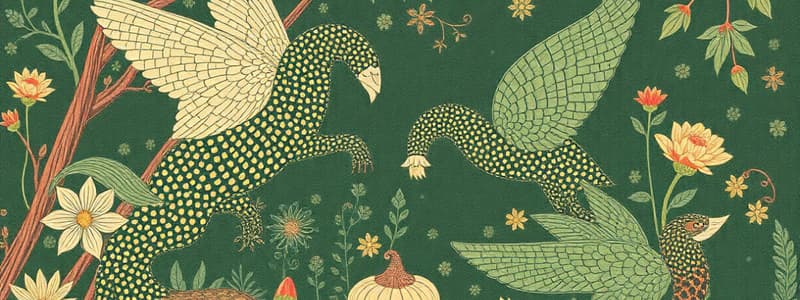Podcast
Questions and Answers
Define the term 'ecosystem' and include an example.
Define the term 'ecosystem' and include an example.
An ecosystem is a distinct self-supporting system of organisms interacting with each other and with the physical environment. An example is a forest ecosystem.
What are abiotic factors and provide three examples?
What are abiotic factors and provide three examples?
Abiotic factors are non-living elements of an ecosystem. Examples include sunlight, water, and soil nutrients.
What is the difference between interspecific and intraspecific competition?
What is the difference between interspecific and intraspecific competition?
Interspecific competition occurs between different species, while intraspecific competition occurs between members of the same species.
Explain the role of producers in an ecosystem.
Explain the role of producers in an ecosystem.
Signup and view all the answers
Identify and describe two types of consumers and their roles in the ecosystem.
Identify and describe two types of consumers and their roles in the ecosystem.
Signup and view all the answers
What distinguishes carnivores from herbivores?
What distinguishes carnivores from herbivores?
Signup and view all the answers
Define detritivores and provide two examples.
Define detritivores and provide two examples.
Signup and view all the answers
Explain the role of decomposers in the ecosystem.
Explain the role of decomposers in the ecosystem.
Signup and view all the answers
What is the main interaction in a predator-prey relationship?
What is the main interaction in a predator-prey relationship?
Signup and view all the answers
How might the visual acuity of eagles benefit them as predators?
How might the visual acuity of eagles benefit them as predators?
Signup and view all the answers
What are some structural adaptations that predators may possess?
What are some structural adaptations that predators may possess?
Signup and view all the answers
Why are omnivores able to utilize both plant and animal sources?
Why are omnivores able to utilize both plant and animal sources?
Signup and view all the answers
What does the term 'intraspecific competition' refer to?
What does the term 'intraspecific competition' refer to?
Signup and view all the answers
Describe how the populations of predators and prey might fluctuate.
Describe how the populations of predators and prey might fluctuate.
Signup and view all the answers
Can you explain the difference between detritus and humus?
Can you explain the difference between detritus and humus?
Signup and view all the answers
Study Notes
Ecological Relationships
- Ecology describes the living world
- An ecosystem is made up of living (biotic) and non-living (abiotic) factors
- A species is a group of organisms of one type living in the same place at the same time
- A community is made up of different species populations
- A biosphere is the living world (all parts of Earth where life is found)
- A habitat is the place where specific organisms live
- A population is all the organisms of a particular species in an ecosystem at one time
- An ecosystem is a self-supporting system of organisms interacting with each other (biotic factors) and the physical environment (abiotic factors)
Competition
- Interspecific competition: between members of different species
- Intraspecific competition: between members of the same species
- Plants compete for light, water, minerals (nutrients), and space
- Animals compete for food, water, mates, and territory
Feeding Relationships
- Producer/autotroph: an organism that produces its own food (e.g., plants, algae) through photosynthesis
- Consumer/heterotroph: an organism that consumes other organisms
- Herbivore: eats only plants
- Carnivore: eats only animals
- Omnivore: eats both plants and animals
- Detritivore: breaks down dead organic matter (e.g., dung beetles, earthworms)
- Decomposer: breaks down dead organic matter through external enzyme release (e.g., bacteria, fungi)
Predator-Prey Relationships
- Predation: one organism (predator) hunts, kills, and feeds on another organism (prey)
- Predators and prey populations are linked.
- Predators have adaptations that help them catch prey (e.g., speed, sharp teeth)
- Prey have adaptations that help them avoid predators (e.g., camouflage, speed)
- Predator-prey relationships show fluctuations over time, due to factors like food availability, disease or climate. This is visible in graph patterns.
- High prey population leads to increasing predator population, leading to a decline in prey population, as resources become scarce, and cyclical pattern repeats.
- Snowshoe hare and Canadian lynx populations fluctuate in cycles related to predation.
Studying That Suits You
Use AI to generate personalized quizzes and flashcards to suit your learning preferences.
Related Documents
Description
Test your knowledge on ecological relationships, including ecosystems, species interactions, and competition. This quiz covers key concepts such as biotic and abiotic factors, population dynamics, and food chains. Perfect for students studying ecology!




